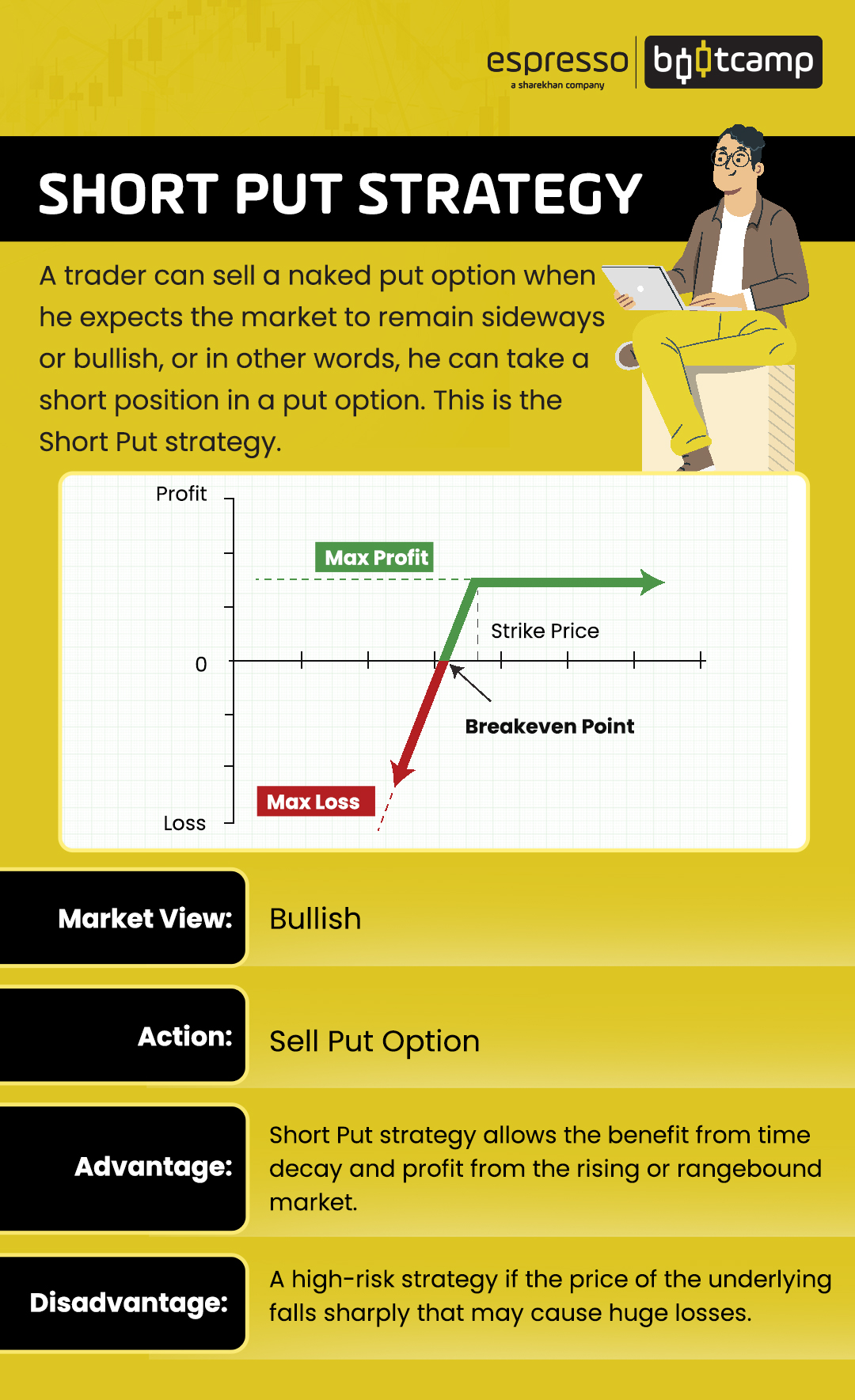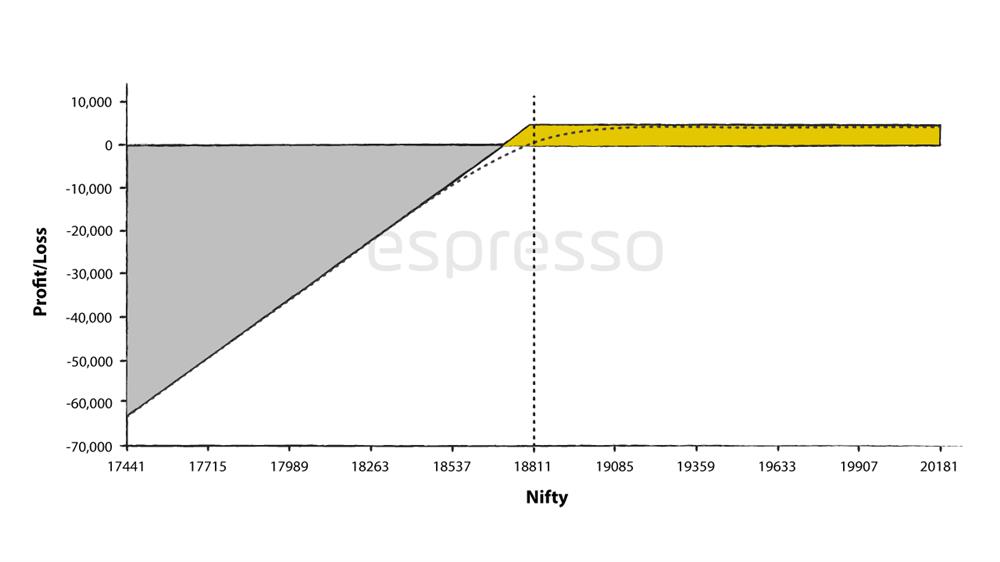06. Short Put Option: What It Is and How to Trade a Short Put

A Short Put position indicates that the underlying will move higher.

The position refers to a trade when the trader sells or writes a Put option intending to make money when the underlying rises.
The writer (short) of the put option receives the premium, which is the price at which the option is sold. This amount is also the maximum that the trader can hope to achieve from the trade.
A short put writer will lose money if the underlying falls. Theoretically, the Put writer has the potential to incur unlimited losses.
What is a Short Put?
A short put is when a trader sells or writes a put option.
The short put trader initiates the trade when he believes the underlying will rise. The trade is like buying a call option, except that it has the potential of limited profit and unlimited losses.
The diagram below shows the Payoff diagram of a Short Put.
 The logic behind taking a short put trade is to profit from a rise in the underlying stock's price.
The logic behind taking a short put trade is to profit from a rise in the underlying stock's price.
The Payoff chart shows that a Short Put trade has been created by selling a 18800 08 DEC 2022 Put.
The Nifty Put was sold at a premium of Rs 95 which would fetch the trader Rs 4,700 (95 X 50).
The Breakeven for the trade is 18,706 (18800-95); that is the difference between the premium collected and the strike at which the Put was sold.
The strategy’s profit is capped at the premium collected and will remain the same despite the market moving higher.
Theoretically, the strategy has the potential of unlimited loss if the underlying keeps falling.
Short Put basics
A short put is an opposite of buying a put. Selling a Put option is shorting a Put option. This means the trade will make a profit when the prices increase and will be at a loss when it falls.
When a trader shorts a put option, he is selling the rights to sell short the underlying stock at a later date, which can be any time before the expiry, at a predetermined price known as the strike price, and a fixed number of shares, known, as the lot size.
The goal of a short put seller is to make the maximum profit if the underlying asset’s price stays at or above the strike price until the option expires. This will make the option worthless, and the trader will pocket the entire premium.
Having said that, a short put options trade is risky because the underlying’s price could fall significantly below the strike price. This makes the Short Put a riskier option than a Long Call, which also bets on making money if the market rises.
Assuming an investor is accumulating a stock at Rs 100, it is presently trading at Rs 110. Rather than sitting idle and waiting for the stock to fall, the trader would sell a Rs 100 Put. This way, if the stock moves higher, he would not repent for missing out on the opportunity and still make something from the trade (collect the premium).
However, if the stock falls and goes below, he would be happy to purchase the stock. In this case, his acquisition cost has also been reduced by the amount of premium collected.
If an investor sells a put option, then he is obligated to purchase the shares if the put buyer exercises the option.
The Short Put strategy can be costly for a speculator who is selling Puts with no intentions of buying the underlying and holding on to his position as the market falls.
If the price of the underlying is above the strike price at which the put option was sold, the option will expire worthlessly, and the writer gets to keep the premium.
However, if the underlying price falls below the strike price, the profitability for the writer falls to the point of breakeven, and beyond it, he faces potential losses.
When to initiate a Short Put trade
A Short Put trade is initiated when the trader thinks that the price of the underlying will increase, albeit slowly.
The ideal situation under which a Short Put trade can be created is when implied volatility (IV) is high. This offers a higher premium which will help the trader improve their return on investment (ROI).
To ascertain the right volatility when selling a Put, the trader can use the Implied Volatility Rank (IVR) or Implied Volatility Percentile (IVP).
Short Puts versus Long Calls
Both the Short Put trade and the Long Call trade benefit when the price of the underlying rises.
A long call options trade has a theoretical opportunity of unlimited gains, while the gains of a short put trade are restricted to the amount of premium collected.
If the price of the underlying refuses to move higher and instead falls, the loss of a Long Call will be restricted to the amount paid for the premium. But the short call trader has a theoretically unlimited loss opportunity.
If the underlying does nothing or just moves in a small range, the Long Call trade loses money, while the Short Put trade benefits from price decay.
Short Puts and Covered Short Puts
There are two types in which a Short Put trade can be created. While the primary action in both cases is selling a put, a Covered Short Put is called when the trader takes a short position by either short-selling a future or buying a put of a different strike. The idea here is to provide a cover for the short position. A naked put has unlimited loss potential if the underlying starts falling.
Factors to consider while taking a Short Put trade
Impact of underlying price change
A Short Put trade normally moves in the opposite direction of the underlying. However, this is never the case. The relationship between the underlying and the put option is loosely dependent on the value of the Options Greek called Delta. Thus, if an option has a Delta of 0.20, then for every 100 points move of the underlying, the option will move by 20 points.
Depending on the distance the trader expects the market to move, he can select the option strike price and pick up the one offering his target returns.
Impact of volatility
Option sellers generally prefer to take the trade in a highly volatile environment as it offers them a higher premium to eat. The ideal time for taking a Short Put trade can be based on the implied volatility rank (IVR) or implied volatility percentile (IVP). A higher rank or percentile would offer the trader a good return on investment opportunity when volatility falls
Impact of time
Time is an option seller's friend. With time, the value of the option deteriorates, thus giving the trader a higher probability of winning, even if the price does not rise. A Short Put trade can end up in profit even if the direction is wrong but has failed to cross the breakeven point by the time of expiry.
Impact of stock price change
Put prices, generally, do not change rupee-for-rupee with changes in the price of the underlying stock. Rather, puts change in price based on their "delta". ATM puts typically have deltas of approximately 50. So, a Re 1 rise or fall in stock price causes an at-the-money (ATM) Put to rise or fall by Rs 0.50. ITM puts Puts tend to have deltas greater than 50, but not greater than 100. OTM puts Puts have deltas less than 50, but not less than zero.
Impact of change in volatility
Volatility measures how much a stock price fluctuates in percentage terms. Volatility is a factor in option prices. As volatility rises, option prices tend to rise if other factors, such as stock price and time to expiration, remain constant. As a result, Short put Put positions tend to lose in a rising volatility scenario and benefit during decreasing volatility.
Impact of time
The time value portion of an option’s total price decreases as expiration approaches. This is known as time erosion. For Short Put trades, this is an important contributor to its success.
Conclusion
A Short Put trade offers limited profit opportunities but unlimited loss. However, the trade, which is a sell options trade, has a high probability of success as even if the underlying does not move higher but remains at the same place, the Short Put trade will make money.
The Short Put trade is a building block that can be mixed with other option building blocks to form complex strategies.
 0
|
0
|
 0
0
 Modules
Modules
 Watch
Watch 
